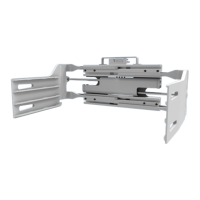- 11 -
安全操作和维护
S
AFE OPERATION AND MAINTENANCE
(OSHA REGULATIONS)
(3) Unauthorized personnel shall not be permitted to ride on powered industrial trucks. A safe place to ride shall be provided where
riding of trucks is authorized.
(4) The employer shall prohibit arms or legs from being placed between the uprights of the mast or outside the running lines of the
truck.
(5i) When a powered industrial truck is left unattended, load engaging means shall be fully lowered, controls shall be neutralized,
power shall be shut off and brakes set. Wheels shall be blocked if the truck is parked on an incline.
(5ii) A powered industrial truck is unattended when the operator is 25 feet or more away from the vehicle which remains in his view,
or whenever the operator leaves the vehicle and it is not in his view.
(5iii) When the operator of an industrial truck is dismounted and within 25 feet of the truck still in his view, the load engaging means
shall be fully lowered, controls neutralized and the brakes set to prevent movement.
(6) A safe distance shall be maintain from the edge of ramps or platforms while on any elevated dock or platform or freight car.
Trucks shall not be used for opening or closing freght doors.
(10) A load backrest extension shall be used whenever necessary to minimize the possibility of the load or part of it from falling
rearward.
(n) Traveling
(4) The driver shall be required to slow down and sound the horn at cross isles and other locations where vision is obstructed. If
the load being carried obstructs forward view, the driver shall be required to travel with the load trailing.
(7i) When ascending or descending frades in excess of 10 percent, loaded trucks shall be driven with the load upgrade.
(7ii) On all grades the load and load engaging means shall be tilted back if applicable, and raised only as far as necessary to clear
the road surface.
(o) Loading
(1) Only stable or safety arranged loads shall be handled. Caution shall be exercised when handling off-center loads which cannot
be centered.
(2) Only loads within the rated capacity of the truck shall be handled.
(3) The long or high(including multiple-tiered) loads which may affect capacity shall be adjusted.
(4) Truck equipped with attachments shall be operated as partially loaded trucks when not handling a load.
(5) A load engaging means shall be placed under the load as far as possible; the mast shall be carefully tilted backward to stabilize
the load.

